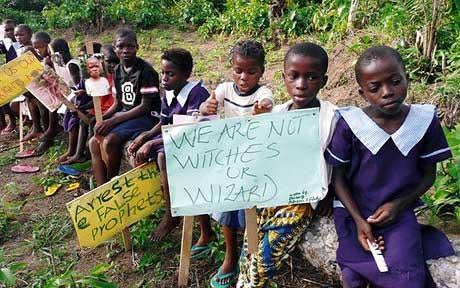The First Church of Sons of Lucifer.
As someone who once devoted my life to Christianity, my journey has been anything but conventional.
After facing persecution from the church for my outspoken views on the victimization of suspected child witches, I found solace in Satanism. This transition was not born out of rebellion but from a deep-seated belief in individual freedom and a rejection of unjust practices.
That was when I teamed up with the First Church of Sons of Lucifer, a foundation to support alleged child witches to connect spiritually. They hold talk forums to help these kids without the negativity that follows
Now, as a practicing Satanist, I want to offer my perspective on the often-misunderstood religion, its intersection with child witchcraft, and the role the church has played in perpetuating harmful practices.
My issues with the church began with its treatment of children accused of witchcraft. These children, often innocent and vulnerable, were subjected to horrific abuses based on unfounded accusations. I strongly believed that our role should be to protect and support these children rather than ostracize or condemn them. Unfortunately, my advocacy for these children was met with hostility and resistance from church leaders, who viewed my views as controversial and unwelcome. This opposition ultimately led to my exclusion from the church.
It was during this period of estrangement that I discovered Satanism. Contrary to the popular misconceptions, Satanism is not about worshipping the devil or engaging in malevolent activities. Instead, it represents a commitment to individual autonomy, self-empowerment, and a critical examination of traditional authority. In Satanism, we prioritize personal responsibility and reject moral absolutism, which often leads to judgment and persecution. It’s about embracing individual freedom and fostering a sense of self-worth without adhering to rigid dogmas.
The church’s portrayal of Satanism as inherently evil or malevolent is a severe misrepresentation. Satanism, as practiced by many, focuses on personal growth and questioning authoritarian structures. It’s a philosophy that champions personal empowerment and ethical conduct based on individual judgment rather than imposed moral codes. Many Satanists are also humanists who are deeply concerned with social justice and ethical behavior, contrary to the fearsome image often portrayed in mainstream narratives.
My advocacy against the victimization of suspected child witches has been a significant part of my journey. The abuses and neglect suffered by these children are appalling and unacceptable. These accusations are frequently driven by superstition and a lack of understanding, leading to tragic outcomes. I have seen firsthand the suffering inflicted on these children, who are often scapegoated for societal problems or personal misfortunes.
The church’s role in perpetuating harmful beliefs and practices, such as exorcisms and deliverance rituals, cannot be ignored. These practices can be particularly traumatic for children, reinforcing a cycle of fear and repression. Instead of providing support and understanding, these rituals often exacerbate the suffering and push individuals toward alternative belief systems, including Satanism. The church’s failure to address these issues compassionately and constructively contributes to a broader culture of fear and persecution.
It is essential to recognize that Satanism is not merely a reaction to religious persecution but a legitimate belief system for those who feel alienated by traditional religions. When individuals are rejected or marginalized by their religious communities, they may seek out alternative beliefs that offer a sense of empowerment and belonging. Satanism, often misrepresented and stigmatized, can be a refuge for those seeking to define their own path outside conventional religious frameworks.
To address the issue of child witchcraft, education and awareness are crucial. We need to challenge and dismantle harmful beliefs, promote empathy, and support organizations dedicated to the protection and rehabilitation of accused children. The media also plays a significant role in shaping public perception, often sensationalizing and distorting information about Satanism and child witchcraft. Responsible reporting and nuanced discussions are essential to counteract misconceptions and provide a more accurate understanding of these complex issues.
The notion that children are practicing witchcraft is often rooted in cultural fears and superstitions rather than any concrete evidence. These accusations frequently serve as a means of societal control or as scapegoats for larger issues. It’s vital to approach such claims with skepticism and prioritize the well-being and mental health of the children involved. Addressing these accusations requires a focus on education, support, and open dialogue rather than punitive measures.
When dealing with suspected cases of witchcraft, the priority should always be the child’s safety and well-being. Engaging with mental health professionals and social workers to address underlying issues is essential. Avoiding harmful practices and focusing on supportive, empathetic approaches will help dispel myths and reduce fear-based reactions. Ensuring that the child feels supported and understood is crucial to their recovery and well-being.
Regarding exorcisms and deliverance, their effectiveness and morality can vary widely depending on the context. While some may find comfort in these practices, they can also cause significant harm if they involve coercion or neglect of medical and psychological needs. It is essential for these practices to be carried out with respect, care, and a genuine concern for the individual’s overall well-being, ensuring that they do not exacerbate existing issues or cause further trauma.
In discussing Yoruba mythology, specifically the deity Esu, it’s important to note that his role is often misunderstood. Esu is a figure associated with communication and chance rather than malevolence. While Esu embodies duality and challenge, he is not inherently evil. In contrast, Satanism typically involves a more explicit rejection of traditional religious norms and embraces themes of defiance and self-interest. Although both Esu and Satanism involve themes of challenge and testing, their cultural and theological contexts are distinct.
Finally, the distinction between Satanists and Luciferians is worth noting. Satanists, particularly those aligned with modern forms like LaVeyan Satanism, use Satan as a symbol of rebellion against authoritarian religion and individualism. Luciferians, however, often focus on Lucifer as a symbol of enlightenment and personal growth. While there may be overlapping themes of personal freedom, their core philosophies diverge significantly.
To those struggling with their faith or feeling marginalized by their church, I offer this message: you are not alone, and there are alternative paths that can offer personal growth and empowerment. Satanism, for example, provides a framework for questioning authority and embracing individual values. Don’t let fear or stigma deter you from exploring beliefs that align with your values and offer a sense of belonging.
This reflection comes from my journey through faith and disillusionment. It’s a call for understanding, compassion, and a thoughtful examination of how religious institutions impact individuals and communities.
By Brother Rose
The post Satanism, Child Witchcraft, and the Role of the Church: A Personal Reflection appeared first on Latest Nigeria News | Top Stories from Naomisophyblog.









